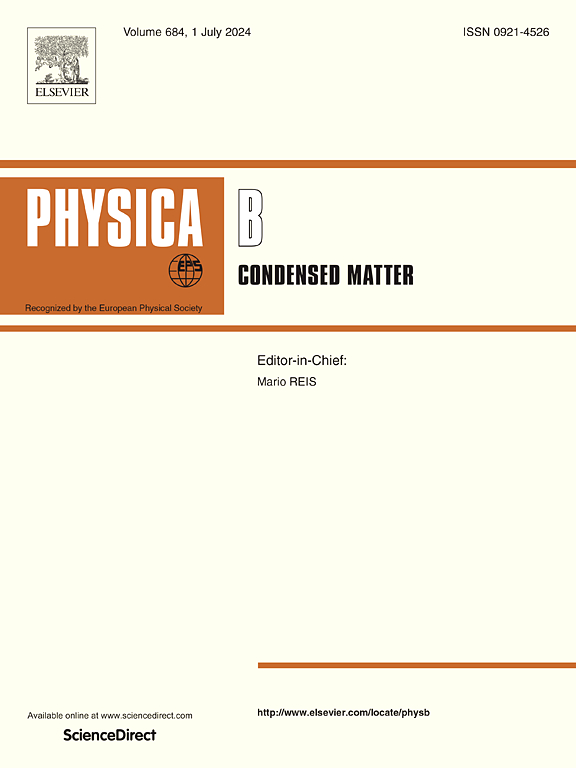Photoluminescence properties of SnO2 nanoparticles doped with group VI elements (Cr, Mo, W) synthesized by pulsed laser ablation in liquid
IF 2.8
3区 物理与天体物理
Q2 PHYSICS, CONDENSED MATTER
引用次数: 0
Abstract
Tin oxide nanoparticles (SnO2 NPs), both pure and doped with Group VI (G6) metal ions (Cr+3, Mo+5, and W+6), were synthesized using pulsed laser ablation in liquid. This study aimed to investigate the effect of G6 doping on the electronic properties of SnO2 NPs, with an emphasis on enhancing their photoluminescence for optoelectronic applications. Transmission electron microscopy revealed well-crystallized samples with diameters of 3–6 nm, indicating quantum-confinement effects. The optical band gap, determined by UV–Vis spectroscopy, was reduced from 5.1 eV (undoped) to 4.9 eV (Cr-doped) due to defect states, while increasing to 5.3 eV and 5.7 eV for Mo- and W-doped SnO2, respectively, due to the Moss-Burstein effect. The photoluminescence spectra exhibited a redshift, with strong red emission around 700 nm, which was up to 90 % more intense than that of the undoped SnO2. This enhancement was attributed to the 2E→4A2 transition and increased defect states.
在液体中通过脉冲激光烧蚀合成的掺杂 VI 族元素(铬、钼、钨)的 SnO2 纳米粒子的光致发光特性
本研究利用脉冲激光烧蚀技术在液体中合成了纯氧化锡纳米粒子(SnO2 NPs)和掺杂第六族(G6)金属离子(Cr+3、Mo+5 和 W+6)的氧化锡纳米粒子(SnO2 NPs)。本研究旨在探讨 G6 掺杂对 SnO2 NPs 电子特性的影响,重点是增强其在光电应用中的光致发光性能。透射电子显微镜显示了直径为 3-6 纳米的良好结晶样品,表明其具有量子会聚效应。通过紫外可见光谱测定,由于缺陷态,光带隙从 5.1 eV(未掺杂)减小到 4.9 eV(掺杂铬),而由于莫斯-伯斯坦效应,掺 Mo 和 W 的 SnO2 的光带隙分别增大到 5.3 eV 和 5.7 eV。光致发光光谱表现出红移,在 700 纳米附近有强烈的红色发射,其强度比未掺杂 SnO2 高出 90%。这种增强归因于 2E→4A2 转变和缺陷态的增加。
本文章由计算机程序翻译,如有差异,请以英文原文为准。
求助全文
约1分钟内获得全文
求助全文
来源期刊

Physica B-condensed Matter
物理-物理:凝聚态物理
CiteScore
4.90
自引率
7.10%
发文量
703
审稿时长
44 days
期刊介绍:
Physica B: Condensed Matter comprises all condensed matter and material physics that involve theoretical, computational and experimental work.
Papers should contain further developments and a proper discussion on the physics of experimental or theoretical results in one of the following areas:
-Magnetism
-Materials physics
-Nanostructures and nanomaterials
-Optics and optical materials
-Quantum materials
-Semiconductors
-Strongly correlated systems
-Superconductivity
-Surfaces and interfaces
 求助内容:
求助内容: 应助结果提醒方式:
应助结果提醒方式:


